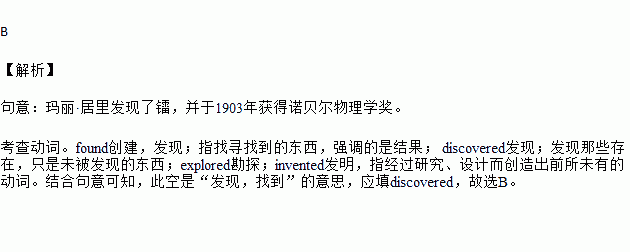题目内容
Marie Curie __________ radium and won the Nobel Prize for Physics in 1903.
A.found B.discovered C.explored D.invented
 一课一练课时达标系列答案
一课一练课时达标系列答案AI(人工智能)makes our lives easier and better. Let’s see the amazing AI.
Cool driverless bus A bus door opens and you get on. Wait, where is the driver? Here is a new kind of driverless bus called Apolong. It can seat 14 people and doesn’t need a driver. The bus follows traffic rules. It stops every time it sees a stop light. | Your close friend Hi, everyone. I’m Xiaoice, a chatbot(聊天机 器人). I speak like a 17-year-old-girl. If you feel lonely, you can talk with me. I’m good at singing, writing poems and telling stories. I want to be your friend! |
World’s first AI anchor Hey, look! The famous Chinese anchor( 主播) Qiu Hao is reporting the news for us. But, is “he” really Qiu Hao? The answer is “no”. This is the world’s first AI anchor. It looks and speaks just like a real person. It speaks both Chinese and English. It can work 24 hours without any mistakes. The AI anchor joins Inhuman reporting team. You might see it on TV soon. | Popular AI artist This beautiful painting was at an auction(拍卖) in 2018. It sold for about 3,000,000 yuan! But it is not a work by a famous painter, such as Vincent van Gogh. It was painted by an AI artist. Three Frenchmen created the AI. The AI artist studied over 15,000 paintings. In this way, it learned to paint. Now it is among the most popular artists in the world. |
1.The fact about Apolong is that _____.
A. There is a driver in it B. the door is opened by the passenger
C. there are 24 seats in it D. it stops every time it sees a stop light
2.Xiaoice CAN’T _____.
A. go out to play with you B. talk with you if you feel lonely
C. be your friend D. sing, write poems or tell stories
3.The painting is ______.
A. a work painted by Vincent Van Gogh
B. worth about 3,000,000 yuan at an auction
C. studied by three French artists over 15,000 times
D. among the most beautiful paintings in the world
4.Which of the following is TRUE according to the passage?
A. Xianice is a 17-year-old girl.
B. The AI anchor can only speak English.
C. The AI anchor can work 24 hours without mistakes.
D. The AI artist is one of the most popular artists in China.
5.We can probably see the passage in _____.
A. a guidebook B. a notice C. a novel D. a newspaper
Editor’s notes: Shanghai Disneyland has created discussions on Chinese social media because of its VIP service, which allows high-paying customers to skip lines for rides and attractions. Do you support this service?
YES | Student A Paying special fees is seen as a normal business behavior. Disneyland is a for-profit (盈利) theme park, which means it has to find ways to make money. Guests who get to jump the queue have paid an extra fee, so why should we blame them? |
Student B According to Disneyland’s rules, VIPs may cut in line. After all, they have spent more money. If you buy a first-class ticket on a plane, you receive better treatment. And in banks, there are VIP windows for special customers. Spending more money is just a choice. | |
NO | Student C I think this service is a bad idea. First, it’s unreasonable to build one’s happiness upon others’ pain, so being rich doesn’t mean we can do whatever we want. Second, this rule may teach children that people can solve any problem with money, which is a misleading (误导) attitude (态度) towards life. |
Student D I don’t agree with paying extra money to cut in line. Though it’s convenient for VIP visitors, it wastes other tourists’ time, leaving a very bad impression on them. To make the matter worse, children will see that the world isn’t fair to everyone, which will be bad for the development of their values. |
阅读以上信息, 用恰当的单词完成下面的短文, 每空一词。
The hot topic “Should paying extra money lead to better treatment?” is being discussed. Some agree to it. Some are 1. it. People who support it think we have no 2. for blaming tourists who pay more, because they think there are first-class tickets on a plane or VIP windows in banks. Those people who 3. to it think that “paying more equals better treatment” may mislead children that all the 4. can be solved with money. And someone’s cutting in not only breaks rules, but also 5. other visitors badly. What’s your opinion?

